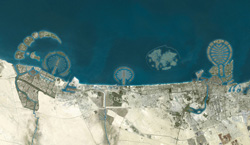
Our grand adventure in Dubai, Abu Dhabi and Egypt was a window into the impact of globalization on the modern Middle East, and an ideal mix of business and tourism.
It goes without saying—one cannot really appreciate the economic, cultural or political complexities of today’s world without understanding the impact of globalization. Hand-in-hand with technology, no other forces have reshaped our lives more over the last two decades.
New York Times columnist Thomas Friedman is perhaps globalization’s most influential observer. His seminal book, The World is Flat, distills its driving trends into a compelling narrative. Friedman suggests that the world has become smaller—“flat”—as technology has removed geographic and other boundaries from the flow of information and trade, creating a level playing field for competition among industrial and emerging market countries. As such, the United States must adapt to these changes and unlock new paradigms of innovation if it expects to maintain its dominance in the 21st century.
Even as the title of Friedman’s book entered the lexicon, financial strategist David Smick responded with The World Is Curved: Hidden Dangers to the Global Economy. Despite its title, Smick’s book is not a rebuke of Friedman’s thesis, but an extension and enhancement of it. Publisher’s Weekly describes his argument this way: “The uncertainty produced by globalized financial markets has created a world that is curved, where events and their consequences are unpredictable.” One need not look far to witness Smick’s curved world metaphor in action.
Whether flat or curved, nowhere in the world is the impact of globalization more evident than in Dubai, an emirate and the most populous city in the United Arab Emirates (UAE). In just twenty years, this sleepy fishing village has transformed itself into one of the fastest-growing cities in the world, a hotbed for tourism and a leader in world trade.
So when I was invited to join a group from central Illinois on a ten-day trip to the UAE and Egypt, I naturally jumped at the chance. Certainly, there would be no better opportunity to experience the impact of globalization up close. As it would happen, our visit occurred at a unique moment in time—just as the U.S. financial crisis was spilling into the world economy, with unpredictable, cascading effects.
Each year, Dr. Amir Al-Khafaji, chair of Civil Engineering and Construction at Bradley University, leads the department’s Global Explorers program, which provides students an opportunity to study abroad and learn about other cultures. A seasoned world traveler, he planned the itinerary and details of our journey—several days in Dubai and Abu Dhabi, and a week in and around Cairo, Egypt.
The purpose of our visit was partly tourism, but several business meetings were arranged as well. “We will have the opportunity to meet with business leaders from each of the respective countries to learn how they do business and what opportunities may exist for teaming with companies in the Middle East on projects over there or ventures in the U.S.,” explained River City Construction Vice President Jim Barr. “I think that these meetings will be worthwhile even for those of us who don’t expect to take advantage of such an opportunity.”
Having organized two major international construction conferences in Peoria, Dr. Al-Khafaji put his Rolodex to work. “I have sent more than 50 emails to many VIPs, business organizations and government officials,” he said. “We will meet with some impressive people in both countries.” It promised to be a grand adventure—guaranteed to affect the perspective of a landlocked Midwesterner—and an ideal mix of business and tourism.
If God is Willing
A week before the trip, our group met to review the basics: visa requirements, weather forecasts, language barriers, dress codes, technology differences, food and water safety, and cultural differences. We discussed the differences between the economies of the UAE and Egypt and how that might impact us, and it was suggested that we bring gifts to show our appreciation for hospitality shown to us.
We were also introduced to the concept of inshallah, an Arabic phrase commonly used in the Islamic world to indicate hope for a future event. Translated literally, inshallah means “if Allah wills it” or “God willing.” “Having dealt with the Middle East, nothing is certain until it happens,” explained Dr. Al-Khafaji. “The saying of inshallah reflects their way of doing business.”
Inshallah reveals a fascinating cultural difference that arises when doing business in the Middle East. “The original principle of inshallah is that nothing can be guaranteed,” says linguistics expert Dr. Jamshid Ibrahim. “In modern life…it has become a very convenient way of avoiding commitment or even refusal when Muslims are embarrassed to give a clear ‘no’ answer. Thus, the idea of reliability is removed completely, or even the opposite is meant.”
For this reason, many of our proposed meetings and contacts remained tentative, unconfirmed until the last minute, and we were prepared for the schedule to change at a moment’s notice. While inshallah significantly impacted our planning, in the end, God was willing, and our plans went off without a hitch. 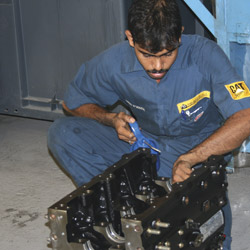 A Big Yellow Welcome
A Big Yellow Welcome
We landed in Dubai on the evening of November 15, 2008. A bus, courtesy of the local Caterpillar dealer, met us on the tarmac and whisked us away to an elegant VIP area, where we were offered tasty hors d’oeuvres and plush seating. Meanwhile, our hosts processed our passports and gathered our luggage for us—gestures for which we were very grateful after a 13-hour flight!
The next morning, we visited the offices of Mohammed Abdulrahman Al-Bahar. Founded in 1939, the M.A. Al-Bahar group of companies became the official Caterpillar dealer for Kuwait and the Lower Gulf states (UAE, Qatar, Bahrain and Oman) in 1959. Its headquarters were moved to the UAE in 1990 after Saddam Hussein invaded Kuwait. With more than $1 billion in sales, Al-Bahar is one of the top Cat dealers in the world. Its machines have been crucial to the development of Dubai.
Again we were greeted with food and drinks, followed by a presentation on Al-Bahar’s history and market outlook, an overview of some of Dubai’s mega-projects, and a tour of their facilities. While not surprising, it was interesting to observe the same pervasive Caterpillar initiatives with which we are so familiar here in central Illinois. Seeing “6 Sigma” spelled in Arabic certainly drives home the global realities of the earth-moving giant’s world!
Recent legislation legitimizing property ownership in Dubai by foreigners has helped to drive its unprecedented growth—and Al-Bahar’s sales of Cat machines. But at the time of our visit, the worldwide implications of the global financial crisis were just becoming clear, forcing significant downward adjustments to market forecasts. As we have seen since, no one is immune to the 21st century global economy—not Caterpillar, not even Dubai.
The tangled web of traffic, mega-skyscrapers and construction cranes that is Dubai truly feels like “Las Vegas on steroids,” as my fellow traveler, Farnsworth Group Vice President Aaron Quick, put it. We were en route to the headquarters of Nakheel, one of Dubai’s leading real estate developers. Nakheel operates under the umbrella of Dubai World, which manages a portfolio of businesses for the Dubai government that also includes DP World, whose aborted 2006 bid to manage six U.S. seaports was the cause of great controversy.
Nakheel’s headquarters lie along the Dubai coast, near the “trunk” of Palm Jumeirah. We were ushered into a state-of-the-art auditorium and given a presentation about the company and its work. Nakheel’s tagline, “Where Vision Inspires Humanity,” is appropriate—its projects are nothing if not visionary feats of engineering. It is responsible for many of Dubai’s most original developments, including its flagship properties, the three Palm islands. Another Nakheel project, The World, consists of 300 man-made islands in the shape of the countries and continents of the world. As if The World was not audacious enough, The Universe is being planned, drawing inspiration from the solar system, with islands in the shape of the sun, moon and planets.
Soon we were cutting across crystal-blue Gulf waters on a private boat tour of the waterfront development around Palm Jumeirah. At the top of this palm tree-shaped island stands the $1.5 billion, ocean-themed hotel Atlantis, which would celebrate its grand opening just days later. The $20 million-dollar bash drew worldwide headlines as A-list celebrities like Robert De Niro, Lindsay Lohan and Michael Jordan witnessed a jaw-dropping fireworks display so massive it could be seen from space. (Visit youtube.com to witness the spectacle for yourself.)
Although among the most lavish parties ever thrown, the Atlantis opening nonetheless seemed to symbolize the final vestiges of an era of unlimited growth. Newsweek called the mood among many of the guests funereal. “As the fireworks exploded, the global economy was imploding.” Even Dubai, it seems, must follow the rules of a playbook just beyond its control.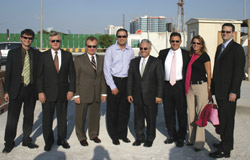
Finding Bradley in Abu Dhabi
There’s not much to see on the 90-minute drive from Dubai to the UAE capital of Abu Dhabi, but that’s set to change as this vast expanse of desert is gobbled up by a chain of developments. The massive, mixed-use Ghantoot City will be one of the anchor projects along this stretch of coast, developed in phases over the next 20 years by International Capital Trading (ICT), a leading investment company and the second-largest landowner in Abu Dhabi.
In Dubai’s Freehold Weekly, ICT Chief Operating Officer Haytham Haidar likens the growth of the two cities to the evolution of Dallas. “Traditionally the area consisted of Dallas and Fort Worth, but now the two have effectively come together.” Likewise, the development between Dubai and Abu Dhabi is leading to an inevitable convergence of the two cities.
We met with Haidar and several others from ICT on our visit. He first met Dr. Al-Khafaji in 2005 at the International Construction Innovations Conference, but his connection to Peoria goes back to the 1980s, when he took classes at Bradley and Illinois Central College while his older brother, Mounir, studied at Bradley.
Bradley University was well represented in Abu Dhabi that day. In addition to our group, which consisted of a Bradley professor and six Bradley graduates, including myself, some of the ICT folks had met with another Bradley grad earlier that morning, another had just watched Bradley basketball on TV. It was a bit surreal—to discover so many connections to Bradley on the other side of the world! Building a Legacy
Building a Legacy
ICT’s $10 billion Ghantoot project is being developed as part of Plan Abu Dhabi 2030, the long-term vision for the emirate. “How do you make [Abu Dhabi] a better place for the individual?” muses Haidar, describing the emirate’s desire to leave an economic, environmental and cultural legacy that will last decades, even centuries. He shares this vision and likens it to a puzzle, each development another piece to carefully put in place. With new guidelines mandating LEED certification (U.S. Green Building Council standard) for a percentage of new buildings, alternative energy and sustainable development were hot topics. It’s becoming a “big, big deal” in the UAE, said Haidar. “We very much desire and seek help.”
A shortage of local consultants presents an opportunity for international firms. “There is a lack of experience in the country as to sustainable design—they can certainly use expertise in that area,” said Farnsworth’s Aaron Quick. “So…if we were interested in doing work over there…[that] is probably the first area in which we would consult, and then we could grow from there.”
After our meeting, Haidar invited us to the sprawling Emirates Palace, a national landmark and one of the most luxurious hotels in the world. We sat down for lunch—and a balmy ocean breeze—on the hotel veranda overlooking the Gulf. Joining us were Mr. Ahmed Ramadan, founder and CEO of Roya International, a leading Dubai-based hospitality consulting company, and Dr. Abdulrahman Al Muhairi, CEO of London’s Cromwell Hospital. We enjoyed a leisurely afternoon, with delicious food and lively conversation, and spoke of the recent presidential election, still fresh on everyone’s minds.
Upon leaving the palace, we stopped at a construction site managed by Mr. Wassim Basha—Bradley alum, class of 1982. It is home to a $700 million project, including twin skyscrapers with a connecting bridge and a five-star hotel. Although we had just finished lunch, we were offered juice, water and cookies—de rigeur for Middle Eastern hospitality. All of the Bradley alumni on hand posed for a photo, and we were off to Sorouh, whose CEO is yet another Bradley graduate who has gone on to amazing things in his career. Communities in Balance
Communities in Balance
Haytham Haidar’s brother, Mounir Haidar, is chief executive officer of Sorouh Real Estate, a public company with a market capitalization of more than $3.5 billion. Prior to joining Sorouh, Haidar headed the technical department and was executive vice president at Nakheel. Recently named one of the six most influential players in Abu Dhabi’s real estate sector, he is a graduate of Bradley University, class of 1981.
Haidar has fond memories of his years at Bradley. At the time, he interned with IDOT and did work on the McCluggage Bridge, which he considers a launching pad for his career. After a stint with Chicago Public Works, Haidar returned to Bradley and obtained his master’s degree before moving on to O’Hare International Airport, where he worked for nearly a decade. Later, he served as a chief consultant to the Greek government on the development of Athens International Airport.
Like his brother, Haidar kindly took time out of his busy schedule to meet with us and discuss Sorouh’s projects in Abu Dhabi. According to the Arab portal zawya.com, Sorouh was founded “with a vision of turning the emirate into a regional leisure, business and lifestyle destination.” The company’s vision statement—“We bring communities to life in perfect balance”—reflected what appeared to be a more thoughtful approach to development in Abu Dhabi than in Dubai.
“Obviously, the tremendous development that has gone on in Dubai in the last decade has been incredible…and unprecedented,” remarked Cliff Baxter of Crawford, Murphy and Tilly. “But it seems like Abu Dhabi has been a little more holistic [in its] planning.”
Aaron Quick felt similarly. “There seems to be little to no long-range planning in Dubai,” he said. “It doesn’t look like a community as much as a series of buildings built as fast and as big as possible, without worrying about things like infrastructure, transportation planning, water management and green space. In Abu Dhabi, obviously they’re moving more slowly…but it seems much more sustainable economically, and from an energy and resources standpoint.”
New resolutions like Dubai’s “Green Roofs” initiative to transform the roofs of buildings to utilize the water emitted by air conditioners convey a more pressing approach to sustainable planning in Dubai, but Abu Dhabi seems to be one step ahead. While in recent years, Dubai has received most of the glory, one gets the sense that Abu Dhabi is uniquely positioned in future years to implement an equally awe-inspiring vision—while avoiding the missteps of its neighbor to the north.
The rivalry between the two emirates is a friendly one. “We complement Dubai and do not see ourselves as a competitor,” said Mounir Haidar to AME Info, a Middle East business portal. “We are developing what Abu Dhabi needs as the capital of the UAE, and trying to catch up with the development which Dubai has pioneered.”
Cradle of Civilization
“Egypt is the cradle of civilization, a country that has developed over thousands of years, where the UAE really has developed primarily in the last six years, since the ruler decided to allow foreign ownership and investment in the country,” remarked Cliff Baxter, on the contrast between the two countries. We flew into Cairo on Emirates, the Middle East’s largest airline, famous for its world-class customer service and state-of-the-art technology. It would be our last taste of the unforgettable “Dubai experience” before encountering the flip side of the globalization equation.
Just as Dubai signifies all that is modern in the Arab world, Cairo embodies the ancient. Abu Dhabi is the richest city in the world, while the streets of Cairo and Alexandria teem with millions of the impoverished and unemployed. The UAE symbolizes development; Egypt stands for excavation—yet both are westernized countries with economies driven by tourist dollars, welcoming to Americans and other foreign visitors.
Driving through parts of Cairo, one is reminded more of war-torn Baghdad than Dubai. Aging high-rises of crumbling limestone stretch for miles—a sea of beige in a dusty prism of smog—across overcrowded neighborhoods dotted by satellite dishes and the domes of ancient mosques. Rubble from the 1992 earthquake still lies uncleared sixteen years later, and garbage is strewn everywhere, choking even the mighty Nile River.
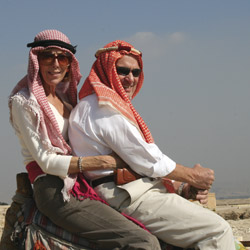
We stayed at the palatial Cairo Marriott Hotel, originally built for the 1869 opening of the Suez Canal, on Zamalek Island. This affluent district offers trendy clubs and cafes for those with means, and serves as a haven for diplomats and foreign tourists, a shield from the widening gap between rich and poor. And yet, despite the bitter realities of poverty in Cairo, we experienced a people in remarkably good spirits.
Obama and the Star-Spangled Banner
With its high unemployment and poverty rates, one might expect the crime rate to be out of control, but that’s not the case—Cairo is, generally speaking, a safe place to live and visit. That security may have something to do with the public presence of military police on nearly every block, the machine guns slung across their shoulders broadcasting a subtle repression. Although it is one of the United States’ closest allies in the region, Egypt is not exactly a haven for democracy and free speech.
Yet it has historically been a tolerant country, with Muslims, Jews and Christians living together in peace for thousands of years. Despite their difficult economic situation, even the poorest of Egyptians are as friendly as can be, going out of their way to help foreign visitors. We also found that they love Americans—and take a strong interest in our new president.
Just two weeks after the election of Barack Obama, our visit could not have been better timed to witness the global reach of American politics—and the global Obama brand. From the cab driver to the shopkeeper, from the tour guide to the desk clerk, nearly everyone we met was captivated by the rise of an African-American to the U.S. presidency. Everywhere we went, it was “Obama, Obama, Obama.” One exception, a Bedouin selling camel rides at the Great Pyramids, offered a comical show of support for his preferred candidate: Hillary Rodham Clinton! Presumably, he was appeased by her subsequent appointment to head the State department.
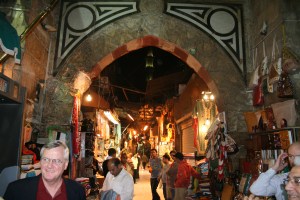 Khan El Khalili, a centuries-old, open-air bazaar, snakes through a maze of narrow streets and alleyways in Islamic Cairo, providing a glimpse of what medieval markets were once like. Our visit there was a highlight of the trip. With the exchange rate working in my favor, I picked up perfume, spices, jewelry, scarves and all sorts of trinkets at very reasonable prices, and found that what I read in my guidebook was true: “The hardest thing about shopping is knowing when to stop.” With no fixed prices, merchants are eager to bargain, a game of give and take that I soon grew to master.
Khan El Khalili, a centuries-old, open-air bazaar, snakes through a maze of narrow streets and alleyways in Islamic Cairo, providing a glimpse of what medieval markets were once like. Our visit there was a highlight of the trip. With the exchange rate working in my favor, I picked up perfume, spices, jewelry, scarves and all sorts of trinkets at very reasonable prices, and found that what I read in my guidebook was true: “The hardest thing about shopping is knowing when to stop.” With no fixed prices, merchants are eager to bargain, a game of give and take that I soon grew to master.
But what I enjoyed more than anything was meeting the wonderful Egyptian people. Rania, our fantastic tour guide. Abdul, the shopkeeper with a wide smile and a big heart. The schoolchildren outside the Mohammed Ali Mosque, who eagerly posed for photos with “the Americans.” The beaming kids who followed us all over Al-Azhar Park. And, most especially, the jovial taxi driver who drove us to Khan El Khalili, a trombone player by night, who proudly told us of his band—and love for Obama—before humming “The Star-Spangled Banner” at the top of his lungs, much to our surprise and delight.
Cell Phones and Infrastructure
With nearly a week in Egypt, we were able to see many sites of antiquity, from the historic mosques, synagogues and churches in the heart of old Cairo to the renowned pyramids and burial chambers outside town. We observed the ancient art of carpet weaving and rode camels near the mighty Sphinx, toured the Roman-era catacombs in Alexandria and dined along the Mediterranean coast. We relaxed at a beach on the Red Sea, stopped by the Suez Canal and toured the new American University in Cairo, which recently moved its campus to the outskirts of the city.
As in the UAE, we also attended a handful of informal business meetings. We first met with the chairman and staff of Hamza Associates, Egypt’s largest architectural/engineering firm, who designed the stunning new library at Alexandria. This was just a general meeting, exchanging introductions and discussing our companies’ areas of expertise. “We always like to take the opportunity to examine possible partnerships,” said Cliff Baxter, “but really there is interest in just learning more about what is going on in the engineering/construction industry in Egypt.”
A few days later, some of us met with representatives of The Arab Contractors (AC), including chairman and CEO Ibrahim Mahlab. One of the leading construction companies in the Middle East and Africa, AC is interested in exploring new construction technologies, practical training and mentorship, and engineering design assistance. Aaron Quick, who attended the meeting, noted, “Because the president of Egypt has announced an infrastructure stimulus program of $2.7 billion to counter recession, they wanted to talk about wastewater, roads, bridges and mid-level housing.”
This meeting provided an example of some of the differences when doing business in the Arab world compared to the U.S. “They tend to answer cell phones during a meeting, so you have to be prepared for that. They aren’t being rude—it is just the way they conduct business meetings,” explained Quick. “In our meeting with 10 people, at one point, five of them were on their cell phones. Amazingly, they can still stay engaged in the discussion!” This is common practice, part of the accessible nature of Arab society.
Both the extended length of our trip and its mix of tourism with business were beneficial. “If we had just come here on a quick business trip, you’d have meetings for two, three four days…then you’d take off and go back home,” noted Quick. “Being over here for ten days, doing the business and tourism, it helps you understand the culture.” And that, as much as the business-to-business interaction, is very important. “You really have to look at the country as a whole…culturally, economically, in the macro sense…and then, of course, build these business relationships.”
World-Weary Travelers
We returned to the states on November 24th. Never before had I so craved a McDonald’s hamburger, or the comfort of my own bed! Two days later, a heavy case of jet lag still gripped me tightly in its clutches when a series of coordinated terrorist attacks hit Mumbai, India. With weary eyes glued to the television, I couldn’t help but feel deeply moved by this tragedy, given how strongly the Taj Mahal hotel resembled the opulent palace we had just left behind in Cairo. That could have easily been us, I thought.
It could have been us in Thailand, where the Bangkok airport was seized by protesters that same week and forced to close, leaving tens of thousands stranded. And though there had been little chance of our being kidnapped by pirates, we were well aware of the dangers lurking in the Gulf of Aden. The same day we landed in the UAE, an enormous Dubai-based, Saudi-owned oil tanker, sailing under the Liberian flag—with crew members from the U.K., Croatia, the Philippines, Poland and Saudi Arabia—was seized by Somali pirates.
Mark Twain once remarked, “Travel is fatal to bigotry, prejudice and narrow-mindedness.” Certainly our journey provided us a unique window, and its timing—just as the financial crisis went international—accentuated our experience of the precarious nature of the interconnected global economy.
As globalization continues to pull us together, that interconnectedness is both a gift and a burden. For the U.S., the playing field has been leveled. No longer the sole dominant superpower, our stature in the world has slipped. Everything is changing more quickly than anyone thought possible, and the faster that change comes, the more intimidating it is—yet the more inevitable it seems. The question remains: Have we recognized what we need to do to thrive in this new world?
Just six days after our return, Nakheel scaled back work on various projects and announced layoffs of 15 percent of its workforce. With property values falling, credit markets seized up and a debt load at more than 40 percent of its GDP, can Dubai continue to fund its ambitious growth? Will all of these mega-projects actually come to fruition, or has this once seemingly invincible juggernaut of development been immobilized? Many believe that the slowdown will help sustain the emirate’s long-term growth, but there will be pain in the short term, just like the rest of us.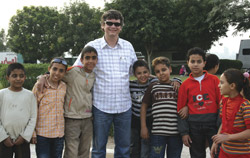 What We Value Most
What We Value Most
As I looked back upon our trip, searching for a message, a theme, lessons learned—it occurred to me. At Caterpillar, we were told that two of the six ultimate factors of success were related to human resources. ICT referred to people as “the commodity that we value the most.” And I recalled what was said at our first meeting: “Personal relationships are very critical in the Middle East.”
Truly, what I will remember most fondly are the people I met along the way. The hospitality of Joe Beydoun in Dubai and Haytham Haidar in Abu Dhabi. Thomas Stoneman, the American expatriate who joined us for a day in the UAE. All of my new Egyptian friends. And, of course, my fellow travelers, most of whom I did not know well before this trip.
No matter where you go, the rise of globalization has not changed this simple fact: that people are what we value most.
There is a plaque on the wall of the Emirates Palace in Abu Dhabi, inscribed with a quote from Sheikh Zayed bin Sultan Ali Nahyan, principal architect of the United Arab Emirates. “The real wealth of a country is not its material wealth; it is its people. They are the real strength from which we draw pride and the trees from which we receive shade. It is our firm conviction in this reality that directs us to put all efforts in educating the people.” iBi


